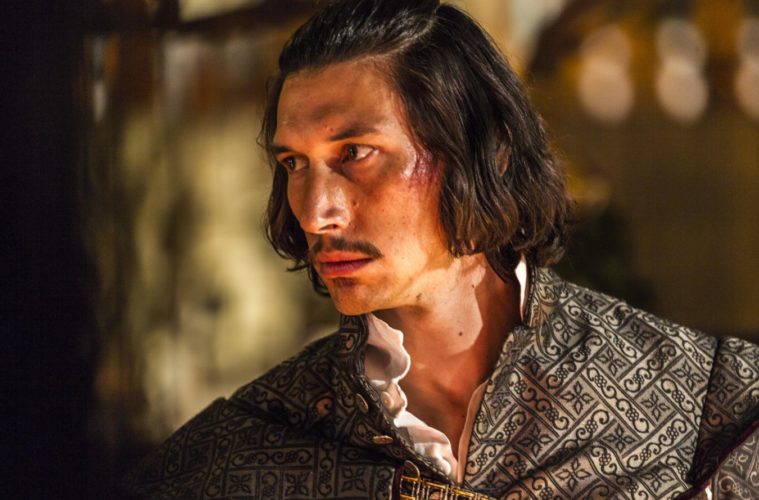Throughout his career as a director, Terry Gilliam has aimed to portray the outlandish and disorderly in imaginative, transportive ways. His greatest achievements are less about narrative coherence than an emotional attachment to a character’s eccentric journey through various stages of bewilderment. His long-burning passion project The Man Who Killed Don Quixote–finally seeing the light of day some 30 years later–clearly aims to be an epic descent into chaos, but the adventure often has trouble conveying a sense of entertaining spectacle to go along with the frivolous bafflement.
Starting things off right in the casting department, Adam Driver plays Toby Grisoni, a jaded director of glitzy ad spots who, ten years prior, made a black-and-white student film titled The Man Who Killed Don Quixote nearby the Spanish village he and his crew are now occupying. While making a new commercial also featuring the characters of Don Quixote and Sancho Plaza, Toby receives a bootleg DVD of his student film from a gypsy and is thrown into a nostalgic look back through his past. As romantic flashbacks of his early filmmaking days are shown, Gilliam renders Toby’s reckoning with his commercialized new lifestyle as he tours the village, Los Sueños, to reunite with those involved in his production.

Most notably, there’s Javier (Jonathan Pryce), a meager cobbler who was cast as Don Quixote and ten years later now fully believes he’s the Cervantes protagonist, wasting his twilight years away in a mostly-deserted tourist attraction. To make matters worse for Toby, Javier presumes that he is his squire Sancho Panza, and so begins a time-jumping adventure for the duo as Javier’s Quixote fights in the name of chivalry and Toby is tasked with pulling him back down to reality. One would think this would be juxtaposed with his present-day production going haywire, but Gilliam is oddly uninterested in making more thoughtful observations about a filmmaker’s contention with dreams versus reality.
Although sprinkled with a few timely nods to the European Union and Trump, most of the script by Gilliam and Tony Grisoni seems like it hasn’t been dusted off since the 1990s, which is both part of the film’s charm and to its detriment. Characters like Angelica (Joana Ribeiro)–the star of Toby’s film, who was perhaps deluded by his words of encouragement–and Jacqui (Olga Kurylenko)–the wife of his boss (Stellan Skarsgård), who has an attraction for Toby–can often feel like one-note objects of affectation for Toby. Things get even more precarious when it comes to Toby’s fondness for his starlet, Angelica, who was 15 at the time of production.
As out-dated as these female supporting roles feel, this is the kind of silly madcap adventure that only Gilliam can dream up, one that has the spirit of being locked in a vault for a few decades. On a shot-to-shot basis, the director comes across like an inventive magician, dreaming up ideas and injecting lunacy in every corner he can, even if it all feels a little been there, done that. Driver is game for the shenanigans with brilliant comedic timing, which directors such as Steven Soderbergh, Spike Lee, and now Gilliam are thankfully utilizing to their advantage. (A gag with a goat creates a particularly humorous spark, as does Toby wiping subtitles off the screen.)

While Gilliam has no shortage of energetic visuals to paint on the screen, Don Quixote is most memorable as a collection of offbeat moments. The director seems a bit lost with the overall story he’s trying to tell. Yes, it’s directly commented on about three-fourths through the film that they may have lost a bit of the plot, but that sense of self-awareness is only barely present in this elongated, two-hours-plus journey. Pryce sells a babbling, spirited lunatic well, of course, but it’s all he’s asked to do and Gilliam believes we have more of an emotional stake in his journey than what comes across.
As his restless camera captures the duo’s escapades, the chaos gets less lucid and more repetitive. With the structure of a film within a film, one may have their own flashbacks to Tropic Thunder, which captures another production gone off the rails, but that script was keen in putting its comedy at the forefront and making sure each joke landed. With The Man Who Killed Don Quixote, Terry Gilliam hopes the audience will simply marvel at the perplexity on screen as much as his characters do, but the slapstick excess ultimately subsumes our investment on both an entertaining and emotional level.
By putting his own twist on the classic of Spanish literature, Gilliam sets the table to pose questions at his own role as a filmmaker and ask if his artistic voice has been swallowed up by the machine of commercialization. That he gets lost in coherently expressing that idea is perhaps a greater comment on his career–and, specifically, this prolonged project–than the film’s narrative could ever dream of communicating. Like his protagonist, Gilliam has been on a life-long quest to convey his idealized, imaginative outlook on life to his audience. The entire saga of The Man Who Killed Don Quixote is compelling in showing the burden that journey can take, even if the end results don’t make for Gilliam’s finest hour (or two).
The Man Who Killed Don Quixote plays on April 10 in theaters nationwide.

